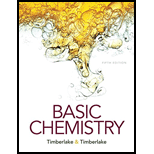
a)
To determine:
According to Dalton’s atomic theory determine the following statement as true or false and if false make it true.-“Atoms of an element are identical to atoms of other elements.”
Concept Introduction:
- The idea of an atomic constituent of matter originated more than 2500 years ago, but no measurable property was assigned to it and the idea remained to be hazy and imaginative in nature. Around 1803, Dalton conceived of atoms as the smallest indestructible part of an element, retaining the characteristics properties of each and capable of combining with other atoms in a chemical manner. This assigned the important measurable property of mass to the atoms and the experimental facts of chemical combination could be explained by this theory with admissible modification.
- The idea of stable indestructible atom as the smallest conceivable particle has undergone drastic revision. A series of experiments and observations recorded decidedly established the atoms consists of several particles which are many times smaller than the atoms they build.
- In a
chemical reaction the atoms of the part of reactant and product remain same, but the combination of atoms to make a compound is changed and no new atom can appear in a chemical reaction.
b)
To determine: According to Dalton’s atomic theory determine the following statement as true or false and if false make it true-“Every element is made of atom.”
Concept Introduction:
- The idea of an atomic constituent of matter originated more than 2500 years ago, but no measurable property was assigned to it and the idea remained to be hazy and imaginative in nature. Around 1803, Dalton conceived of atoms as the smallest indestructible part of an element, retaining the characteristics properties of each and capable of combining with other atoms in a chemical manner. This assigned the important measurable property of mass to the atoms and the experimental facts of chemical combination could be explained by this theory with admissible modification.
- The idea of stable indestructible atom as the smallest conceivable particle has undergone drastic revision. A series of experiments and observations recorded decidedly established the atoms consists of several particles which are many times smaller than the atoms they build.
- In a chemical reaction the atoms of the part of reactant and product remain same, but the combination of atoms to make a compound is changed and no new atom can appear in a chemical reaction.
c)
To determine: According to Dalton’s atomic theory determine the following statement as true or false and if false make it true.-“Atoms of different elements combine to form compounds.”
Concept Introduction:
- The idea of an atomic constituent of matter originated more than 2500 years ago, but no measurable property was assigned to it and the idea remained to be hazy and imaginative in nature. Around 1803, Dalton conceived of atoms as the smallest indestructible part of an element, retaining the characteristics properties of each and capable of combining with other atoms in a chemical manner. This assigned the important measurable property of mass to the atoms and the experimental facts of chemical combination could be explained by this theory with admissible modification.
- The idea of stable indestructible atom as the smallest conceivable particle has undergone drastic revision. A series of experiments and observations recorded decidedly established the atoms consists of several particles which are many times smaller than the atoms they build.
- In a chemical reaction the atoms of the part of reactant and product remain same, but the combination of atoms to make a compound is changed and no new atom can appear in a chemical reaction.
d)
To determine: According to Dalton’s atomic theory determine the following statement as true or false and if false make it true.-“In a chemical reaction some atoms disappear and new atoms appear.”
Concept Introduction:
- The idea of an atomic constituent of matter originated more than 2500 years ago, but no measurable property was assigned to it and the idea remained to be hazy and imaginative in nature. Around 1803, Dalton conceived of atoms as the smallest indestructible part of an element, retaining the characteristics properties of each and capable of combining with other atoms in a chemical manner. This assigned the important measurable property of mass to the atoms and the experimental facts of chemical combination could be explained by this theory with admissible modification.
- The idea of stable indestructible atom as the smallest conceivable particle has undergone drastic revision. A series of experiments and observations recorded decidedly established the atoms consists of several particles which are many times smaller than the atoms they build.
- In a chemical reaction the atoms of the part of reactant and product remain same, but the combination of atoms to make a compound is changed and no new atom can appear in a chemical reaction.
Trending nowThis is a popular solution!

Chapter 4 Solutions
Basic Chemistry Plus Mastering Chemistry with Pearson eText -- Access Card Package (5th Edition)
 ChemistryChemistryISBN:9781305957404Author:Steven S. Zumdahl, Susan A. Zumdahl, Donald J. DeCostePublisher:Cengage Learning
ChemistryChemistryISBN:9781305957404Author:Steven S. Zumdahl, Susan A. Zumdahl, Donald J. DeCostePublisher:Cengage Learning ChemistryChemistryISBN:9781259911156Author:Raymond Chang Dr., Jason Overby ProfessorPublisher:McGraw-Hill Education
ChemistryChemistryISBN:9781259911156Author:Raymond Chang Dr., Jason Overby ProfessorPublisher:McGraw-Hill Education Principles of Instrumental AnalysisChemistryISBN:9781305577213Author:Douglas A. Skoog, F. James Holler, Stanley R. CrouchPublisher:Cengage Learning
Principles of Instrumental AnalysisChemistryISBN:9781305577213Author:Douglas A. Skoog, F. James Holler, Stanley R. CrouchPublisher:Cengage Learning Organic ChemistryChemistryISBN:9780078021558Author:Janice Gorzynski Smith Dr.Publisher:McGraw-Hill Education
Organic ChemistryChemistryISBN:9780078021558Author:Janice Gorzynski Smith Dr.Publisher:McGraw-Hill Education Chemistry: Principles and ReactionsChemistryISBN:9781305079373Author:William L. Masterton, Cecile N. HurleyPublisher:Cengage Learning
Chemistry: Principles and ReactionsChemistryISBN:9781305079373Author:William L. Masterton, Cecile N. HurleyPublisher:Cengage Learning Elementary Principles of Chemical Processes, Bind...ChemistryISBN:9781118431221Author:Richard M. Felder, Ronald W. Rousseau, Lisa G. BullardPublisher:WILEY
Elementary Principles of Chemical Processes, Bind...ChemistryISBN:9781118431221Author:Richard M. Felder, Ronald W. Rousseau, Lisa G. BullardPublisher:WILEY





